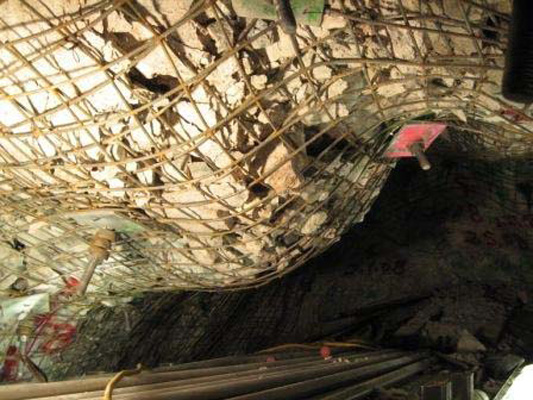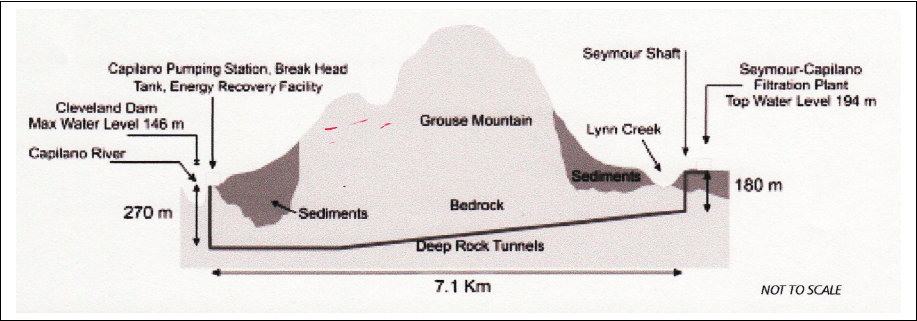Shani Wallis, Editor
- Three prequalified consortia are invited to return proposals by next Friday (January 23, 2009) to take over excavation of the twin Seymour-Capilano TBM water tunnel drives in Vancouver, Canada. The prequalified groups prepared to take up from where the previous effort came to a standstill a year ago on 7 January 2008 are:
-
• The McNally International, Obayashi Corporation, and local contractor Procon Joint Venture;
• The Seymour-Capilano Partnership of Frontier Kemper, JF Shea and AECON; and
• The Seymour-Capilano JV of Dragados, SELI and Schiavoni
-

Original site set-up
- “Once proposals are received, the technical and financial merits of each will be evaluated and the contract awarded to the selected group,” said Bill Morrell, media spokesperson for Metro Vancouver, the catch-all name for regional utilities providers including the project client for the twin tunnels, the Greater Vancouver Water District (GVWD). A date for having the contract awarded was not offered.
- The prequalified consortia have been asked to submit a schedule of time and a fixed-price and a target-cost proposal for completing the project and according to the detailed design specified by project engineer Hatch Mott MacDonald. The successful group will take possession of the construction site and all the equipment mobilized by the previous contractor, the Bilfinger Berger/Fru-Con JV, to build the two 7.1km long x 3.8m diameter rock tunnels and their deep operating shafts at each end.
- When the GVWD terminated Bilfinger Berger’s contract in May 2008, it “exercised its contractual right” and “claimed access to all the equipment” said Morrell. This includes access to and continued use of the two new 3.8m-diameter hard-rock Robbins TBMs procured by Bilfinger Berger for the contract, one bought by Bilfinger Berger and the other rented from Robbins. Through the intervening year, GVWD has maintained the site, ensuring that the sump in the single, 180m-deep working shaft for both tunnels and all intermediate pumps on the existing headings continued to operate, and contracted maintenance of the equipment and of the TBMs. “We are confident the TBMs will be fine,” said Morrell. “They have been maintained and inspected for operational readiness by The Robbins Company. As part of the new bidding process, the short listed proponents were given 48 hours, plus additional time as required, to review the condition of tunnels and the equipment.”
-

3.8m diameter Robbins TBM
- There was no indication from Morrell of an Engineer’s Estimate for the continuation contract. Bilfinger Berger was awarded the original contract in August 2004 after submitting the lowest of three bids at $Can99.65 million - lower than the Engineer’s Estimate and more than $Can86 million below the second bid.
-
Looming trial
As work on resuming the works draws closer, Bilfinger Berger and Metro Vancouver prepare for the court cases that arise from the original contract’s termination - Bilfinger Berger alleging “unlawful and wrongful” dismissal along with other claims, and GVWD claiming refusal by Bilfinger Berger to progress the works according to the design and supervised by Hatch Mott MacDonald. - Termination of the contract followed concerns by Bilfinger Berger for the safety of the workers in light of instability and rock falls in the unlined TBM tunnels. Subsequent inspection by WorkSafeBC, the occupational health and safety executive of British Colombia, confirmed some safety issues that needed attention and requested the employers to delivery an investigation report and a method for ensuring safe continuation of the works. Hatch Mott MacDonald and GWVD report that they addressed the issues, and that a design to cope specifically with claimed ‘rock bursting’ behaviour in the tunnels by Bilfinger Berger was submitted. This was not considered adequate by Bilfinger Berger and GVWD, stating that Bilfinger Berger “declined to progress” the works, resoved the impasse by terminating the contract.
-

Fractured rock in a side wall
- In a recent call to WorkSafeBC, Al Johnson, Regional Director for Construction, told TunnelTalk that Bilfinger Berger had already stopped work when it asked WorkSafeBC to inspect the situation and that, while WorkSafeBC found no violations to cause it to shut down the works, it did agree to work with both parties to develop a method for progressing the works in a safe manner. Johnson could not recall if any of the workers in the Bilfinger Berger tunnelling crews exercised their right to refuse to work in the headings as being unsafe.
- Morrell told TunnelTalk that there has been “no redesign” of the overall project ahead of awarding the continuation contract. The two 7.1km long x 3.8m diameter rock tunnels will continue to be bored downhill from the one 180m deep x 11m diameter operating shaft at the site of the project’s new water treatment plant at Seymour and be retrieved back through the tunnel ahead of creating drill+blast caverns and completing two 275m deep x 4m diameter raisebore shafts at the Capilano end.
- “WorksafeBC hasn't received a Notice of Project of Construction (NOPC) for re-commencement of the project by a new contractor,” said Johnson. “Once that is received, officers will initiate a pre-job meeting with the contractor to review and discuss its health and safety program. Procedures will be reviewed to ensure work is done safely and in accordance with the regulations."
-

Rock instability in the crown
- Completion of the tunnels is not a critical path element of the overall potable water treatment-enhancement project by GVWD. As Project Manager for GVWD Doug Neden explained to TunnelTalk that: “The plant will be commissioned at the end of December 2008 and will treat water from the Seymour reservoir principally. The tunnels are designed to convey water from the Capilano reservoir to the treatment plant and back again to improve the overall quality in the Capilano reservoir and provide an additional supply source. Supply of water to our constituent customers is not compromised by delay of the twin tunnels as part of the overall project.” Morrell confirmed that the filtration plant contractor is currently scheduled to be substantially complete in March. “Testing of systems is now underway,” he said, “with the plant to be online in the spring.
- Arriving at the doors of the courtroom is the result of hardening of uncompromising positions by all parties. The original contract did have a DRB facility but when Bilfinger Berger says it requested that the situation of its perceived unsafe conditions in the tunnels be taken to the DRB, GVWD declined to participate. The contract’s DRB clause required both parties to agree for an issue to be addressed by the DRB panel. As is so often the case in tunnelling, the dispute revolves around the actual conditions encountered, those anticipated, and the specified consequences of meeting claimed unexpected, unforeseen or differing conditions.
- In a copy of the 55-page GBR (geotechnical baseline report) prepared for the contract by Hatch Mott MacDonald, there is no reference to the terms “rock bursts” or “high horizontal stresses”. It does state that the “quality of the granitic bedrock is expected to be predominantly “Good” to “Very Good” with NGI Q-system values greater than Q’=10” and that it is “expected that the TBM excavated tunnels will be largely self-supporting, and will require only nominal levels of local or pattern rock bolts over large portions of the tunnel alignment.”
- Five initial TBM drive support classes are provided with Class V support comprising “Steel Ribs (+ Shotcrete)” in “Extremely Poor” rock, describes as that with a Q rating of <0.1, an RMR of <25, and predicted for a
-

Stable rock
- total 240m of the total 7,100m of each TBM drive. In the 214m of “Very Poor” rock, with a 0.1>Q’ <1 rating and a 25 <RMR <45, the support is for “Full Pattern Bolts (+ Shotcrete) using 2.5m long rock bolts as per the design specifications.
- The GBR also states that “Risks associated with subsurface conditions consistent with, or less adverse than, the baseline conditions represented in the Contract Documents are allocated to the Contractor. Those….more adverse than the baseline….are accepted by the GVWD”. Under the terms of the original contract Bilfinger Berger claims that “GVWD is responsible for providing a safe, viable design” and that it is “responsible for all risks arising from encountered conditions being different than those set out in the project’s GBR”.
- Regarding GVWD’s repossession of the site and access to all the mobilized equipment, Bilfinger Berger reports is has placed a lien against the property of Can$22.5 million for labour and material used to date, and a return of all assets, that total more than $35 million in value including the two TBMs.
-
Future developments
While resolution of the differences between Bilfinger Berger and GVWD are now for a judge to decide, the experience by the new contractors to advance the tunnel headings is yet to be seen. Morrell of Metro Vancouver would not be drawn on any steps taken by GVWD or by its project designer and supervisor Hatch Mott MacDonald as to changes made to contract design, specifications or methodology in coping with rock conditions as they exist where the two TBMs came to a standstill in January 2008 at 4.1km and 3.8km or about 55% into their 7.1km long drives.
-

Fig 1. Section of the alignment
- When TunnelTalk visited the project at the start of Bilfiner Berger’s contract in September 2006, Project Manager at the time Christian Gentschel explained that the greatest risk to the success of the tunnels lies at the far end of the two downhill drives where they pass within a close distance beneath a deep glacial valley in the bedrock that is infilled with waterbearing sediments. A confident prediction by anyone is that things are not going to get easier as work the two long, dead-end headings resumes.
- Vancouvers twin tunnels contract terminated - TunnelTalk, May 2008
Gallery
In response to the article, 'Rebid Reprieve for Seymour-Capilano'
January, 2009
In the article Al Johnson, Regional Director for Construction, WorkSafeBC, discusses shutting down work operations on the Seymour Capilano project and comments that he could not recall if workers exercised their right to refuse to work.
Bilfinger Berger notes that his statements are misleading and inaccurate.
First, on January 22, 2008, WorkSafe BC issued orders to Metro Vancouver and Bilfinger Berger Canada and verbally directed and required the delivery of an investigation report and a safe design before any work was to proceed. To date, neither of the orders has been rescinded. In addition, WorkSafe BC has not approved any plans to resume tunneling or varied its directives to allow any tunneling.
Second, the three unions representing workers on the project all agreed with Bilfinger Berger's decision to stop tunneling after workers were injured. In a May 30, 2008 letter to Metro Vancouver's Greater Vancouver Water District, the three union leaders stated: "After our members were injured and exposed to unsafe conditions at the site, Bilfinger Berger made the correct decision to temporarily suspend the work pending a review and analysis of the rock behavior."
The safety of Bilfinger Berger workers is the company's No. 1 priority. The fact is representative worker unions and their workers are fully onside with Bilfinger Berger's position: They agree that working conditions were not safe; they agree that suspending work was the correct decision; and they have asked Metro Vancouver to review its decision to terminate Bilfinger Berger's contract.
Yours sincerely,
John Penner
Manager, Contracts
Bilfinger Berger Canada Ltd.


